七年级下册英语语法知识点
七年级英语下册语法现在进行时知识点总结
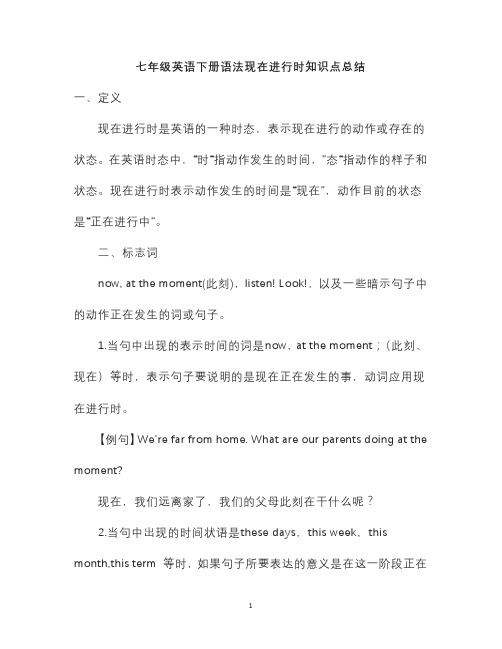
七年级英语下册语法现在进行时知识点总结一、定义现在进行时是英语的一种时态,表示现在进行的动作或存在的状态。
在英语时态中,“时“指动作发生的时间,”态“指动作的样子和状态。
现在进行时表示动作发生的时间是“现在”,动作目前的状态是“正在进行中”。
二、标志词now, at the moment(此刻),listen! Look!,以及一些暗示句子中的动作正在发生的词或句子。
1.当句中出现的表示时间的词是now,at the moment;(此刻、现在)等时,表示句子要说明的是现在正在发生的事,动词应用现在进行时。
【例句】We're far from home. What are our parents doing at the moment?现在,我们远离家了,我们的父母此刻在干什么呢?2.当句中出现的时间状语是these days,this week,this month,this term 等时,如果句子所要表达的意义是在这一阶段正在发生的事,则动词应用现在进行时。
【例句】They're having a test this week.这一周,他们在进行一次考试。
3.在句中出现了Look,Listen,Can't you see? 等暗示词时,说明后面谓语动词的动作正在发生,该动词应用现在进行时。
【例句】Look! Maria and Tom are dancing under the tree.看!玛丽亚和汤姆正在树下跳舞。
这几种动词不用现在进行时1.表示心理情感的动词:want;mind;wish;recognize;think;know;understand;hate;depend on2.表示存在位置的动词:remain;stand3.表示知觉的动词:see;hear;notice;smell4.表示所属的动词:have;possess;own;consist of5.暂时性的动词:accept;allow;decide;promise三、构成肯定句:主语+ am/is/are + 现在分词...【例句】They’re having a meeting now.他们现在正在开会。
最全初一(七年级)英语下册语法知识归纳总结
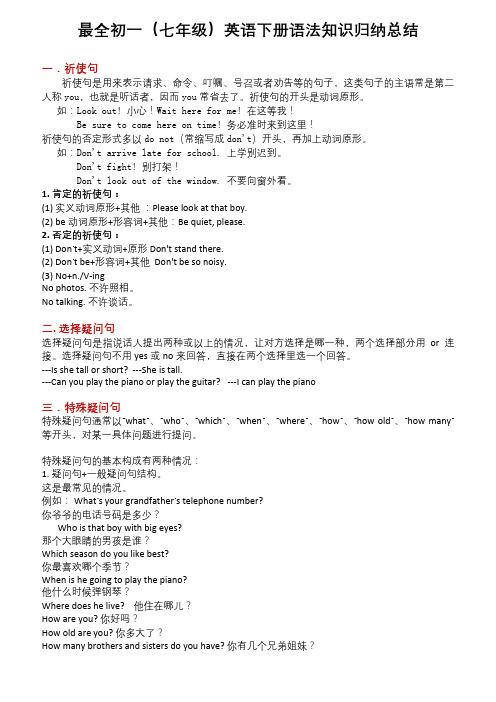
最全初一(七年级)英语下册语法知识归纳总结一.祈使句祈使句是用来表示请求、命令、叮嘱、号召或者劝告等的句子,这类句子的主语常是第二人称you,也就是听话者,因而you常省去了。
祈使句的开头是动词原形。
如:Look out! 小心!Wait here for me! 在这等我!Be sure to come here on time! 务必准时来到这里!祈使句的否定形式多以do not(常缩写成don't)开头,再加上动词原形。
如:Don't arrive late for school. 上学别迟到。
Don't fight! 别打架!Don't look out of the window. 不要向窗外看。
1. 肯定的祈使句:(1) 实义动词原形+其他:Please look at that boy.(2) be动词原形+形容词+其他:Be quiet, please.2. 否定的祈使句:(1) Don’t+实义动词+原形 Don't stand there.(2) Don’t be+形容词+其他 Don't be so noisy.(3) No+n./V-ingNo photos. 不许照相。
No talking. 不许谈话。
二. 选择疑问句选择疑问句是指说话人提出两种或以上的情况,让对方选择是哪一种,两个选择部分用or连接。
选择疑问句不用yes或no来回答,直接在两个选择里选一个回答。
---Is she tall or short? ---She is tall.---Can you play the piano or play the guitar? ---I can play the piano三.特殊疑问句特殊疑问句通常以“what”、“who”、“which”、“when”、“where”、“how”、“how old”、“how many”等开头,对某一具体问题进行提问。
七年级下英语知识点大全

七年级下英语知识点大全七年级下英语是中学英语学习的基础阶段,对学生掌握英语基本语法、词汇、语音、语调等方面起到关键作用。
本文将从以下几个方面为大家梳理七年级下英语的知识点大全。
一、语法1. 一般现在时和一般过去时的构成和用法;2. 肯定形式、否定形式、疑问形式和回答形式的句型构成;3. 简单句和复合句的区别和构成;4. 祈使句、感叹句、陈述句以及疑问句的用法和句型构成;5. 含有情态动词的句子的构成和用法。
二、词汇1. 基本词汇:数字、颜色、天气、家庭、职业、饮食、交通、娱乐、身体各部位、时间等;2. 动词的一般现在时和一般过去时的时态变化和用法;3. 常用介词、副词、形容词、代词、连词等的用法;4. 重点词汇:名词、动词、形容词、副词等的辨析;5. 常用短语和惯用语的用法和意义。
三、语音1. 英语元音、辅音的发音方法及发音区别;2. 重音、轻音的区别及在不同单词中的应用;3. 连读、缩读、语调等基本语音技巧的运用。
四、阅读1. 了解文章结构和主旨;2. 阅读理解的基本方法和技巧;3. 文章中的重点句型和重点词汇;4. 不同类型文章的写作风格和特点。
五、写作1. 熟悉英语的基本句型;2. 如何遣词造句地表达自己的观点;3. 写作技巧和写作准则;4. 书信格式、邮件格式、短文格式等不同类型写作的特点和要求。
六、听说1. 听力技巧和训练方法;2. 默写、听音辨词、听音辨意训练;3. 听力材料的种类和来源;4. 口语练习、语音训练等讲练结合的技巧。
以上就是七年级下英语知识点大全,每个知识点都是相互关联的,只有融会贯通,才能在英语学习中更快地进步。
在学习过程中,一定要注重日积月累,努力掌握基础知识,打牢英语学习的基础。
七年级下册英语语法知识点总结(一)
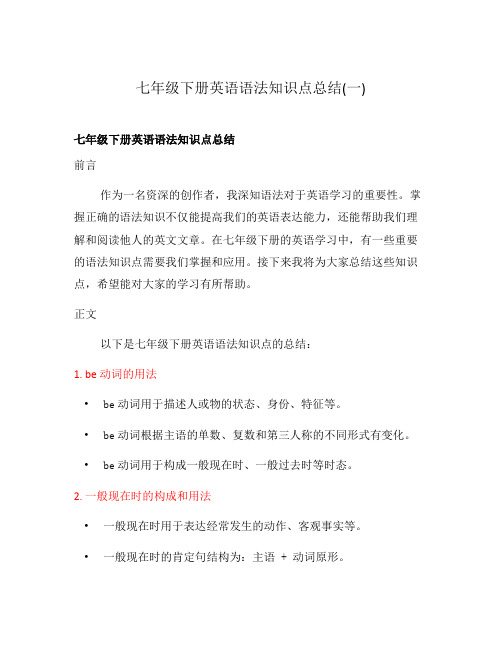
七年级下册英语语法知识点总结(一)七年级下册英语语法知识点总结前言作为一名资深的创作者,我深知语法对于英语学习的重要性。
掌握正确的语法知识不仅能提高我们的英语表达能力,还能帮助我们理解和阅读他人的英文文章。
在七年级下册的英语学习中,有一些重要的语法知识点需要我们掌握和应用。
接下来我将为大家总结这些知识点,希望能对大家的学习有所帮助。
正文以下是七年级下册英语语法知识点的总结:1. be动词的用法•be动词用于描述人或物的状态、身份、特征等。
•be动词根据主语的单数、复数和第三人称的不同形式有变化。
•be动词用于构成一般现在时、一般过去时等时态。
2. 一般现在时的构成和用法•一般现在时用于表达经常发生的动作、客观事实等。
•一般现在时的肯定句结构为:主语 + 动词原形。
•一般现在时的否定句结构为:主语 + do/does + not + 动词原形。
•一般现在时的疑问句结构为:Do/Does + 主语 + 动词原形 + 其他?3. be动词在一般现在时的用法•be动词在一般现在时的肯定句结构为:主语 + am/is/are。
•be动词在一般现在时的否定句结构为:主语 + am/is/are + not。
•be动词在一般现在时的疑问句结构为:am/is/are + 主语 + 其他?4. 一般过去时的构成和用法•一般过去时主要用于描述过去发生的动作或状态。
•一般过去时的肯定句结构为:主语 + 动词过去式。
•一般过去时的否定句结构为:主语 + did not + 动词原形。
•一般过去时的疑问句结构为:Did + 主语 + 动词原形 + 其他?5. be动词在一般过去时的用法•be动词在一般过去时的肯定句结构为:主语 + was/were。
•be动词在一般过去时的否定句结构为:主语 + was/were not。
•be动词在一般过去时的疑问句结构为:Was/Were + 主语 + 其他?•一般将来时用于描述将来要发生的动作或事件。
七年级下册英语语法知识点归纳总结
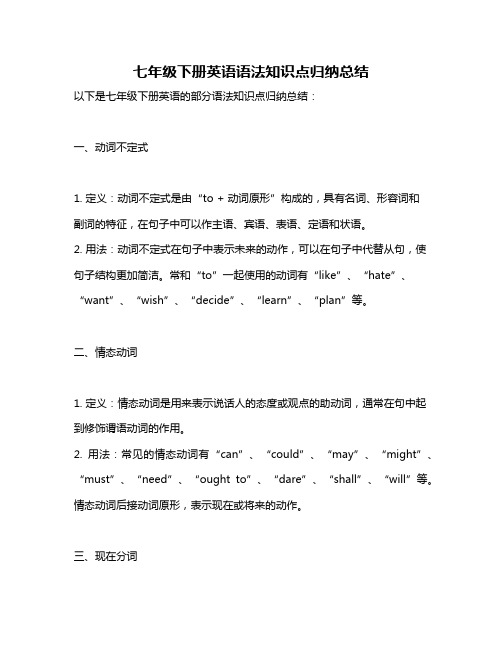
七年级下册英语语法知识点归纳总结以下是七年级下册英语的部分语法知识点归纳总结:一、动词不定式1. 定义:动词不定式是由“to + 动词原形”构成的,具有名词、形容词和副词的特征,在句子中可以作主语、宾语、表语、定语和状语。
2. 用法:动词不定式在句子中表示未来的动作,可以在句子中代替从句,使句子结构更加简洁。
常和“to”一起使用的动词有“like”、“hate”、“want”、“wish”、“decide”、“learn”、“plan”等。
二、情态动词1. 定义:情态动词是用来表示说话人的态度或观点的助动词,通常在句中起到修饰谓语动词的作用。
2. 用法:常见的情态动词有“can”、“could”、“may”、“might”、“must”、“need”、“ought to”、“dare”、“shall”、“will”等。
情态动词后接动词原形,表示现在或将来的动作。
三、现在分词1. 定义:现在分词是动词的一种形式,具有形容词的特征,可以表示正在进行的动作或状态。
2. 用法:现在分词可以作定语、表语和状语。
常和“-ing”一起使用的动词有“seeing”、“feeling”、“thinking”、“doing”、“being”等。
四、介词短语1. 定义:介词短语是由介词和名词或代词构成的短语,用来表示时间、地点、方式等。
2. 用法:介词短语在句子中可以作状语、定语和表语。
常见的介词有“in”、“on”、“at”、“for”、“with”、“by”等。
五、连词1. 定义:连词是用来连接两个句子或从句的词语,表示它们之间的关系。
2. 用法:常见的连词有“and”、“but”、“or”、“so”、“because”、“if”等。
连词在句子中起到承上启下的作用,使句子的意思更加清晰。
以上是七年级下册英语的部分语法知识点归纳总结,希望对你有所帮助。
期末复习人教版英语七年级下册单元重点知识点语法汇总

人教版七年级下册-单元重点语法汇总U1情态动词can的用法can是情态动词,意为“能,会”,表示某人或某物具备的能力,还可用来提出请求,没有人称和数的变化,后面直接接动词原形。
下面学习情态动词can的常见用法。
1.表示“能力”,意为“能,会”。
例句:I can speak English.我会讲英语。
2.表示“请求”或“许可”。
例句:Can you help me with my Chinese?你能帮我学汉语吗?You can go to the park after you finish your homework.你做完作业后可以去公园。
3.含有情态动词can的肯定句变否定句时,需在can后加not,其缩写形式为can’t;变疑问句时,情态动词can直接放在句首,构成一般疑问句。
例句:I can sing English songs.我会唱英文歌。
(肯定句)→I can’t sing English songs.我不会唱英文歌。
(否定句)Yao Ming can play basketball.姚明会打篮球。
→Can Yao Ming play basketball?姚明会打篮球吗?(一般疑问句)4.对Can…问句的回答可以用下面几种形式:对询问能力的问句的回答可以说“Yes,…can.”或“No,…can’t.”,表示对能力的肯定或否定;对表示请求的问句的回答可以说“OK./All right.”,表示同意对方的请求。
也可用certainly或sorry来回答。
用certainly作肯定回答,语气更肯定;用sorry作否定回答,语气则更委婉、客气。
例句:—Can you speak English?你会说英语吗?—Yes,I can.是的,我会。
—Can I see your pencil-box,please?请问,我可以看一下你的铅笔盒吗?—All right./Certainly.Here you are.可以。
七年级英语下册语法总结
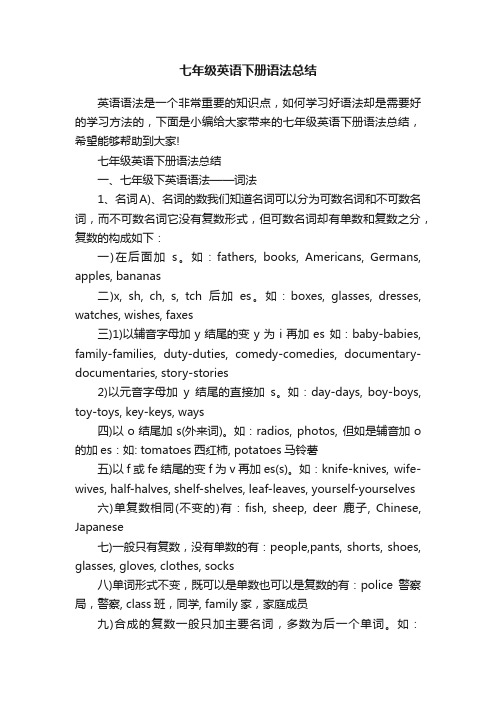
七年级英语下册语法总结英语语法是一个非常重要的知识点,如何学习好语法却是需要好的学习方法的,下面是小编给大家带来的七年级英语下册语法总结,希望能够帮助到大家!七年级英语下册语法总结一、七年级下英语语法——词法1、名词A)、名词的数我们知道名词可以分为可数名词和不可数名词,而不可数名词它没有复数形式,但可数名词却有单数和复数之分,复数的构成如下:一)在后面加s。
如:fathers, books, Americans, Germans, apples, bananas二)x, sh, ch, s, tch后加es。
如:boxes, glasses, dresses, watches, wishes, faxes三)1)以辅音字母加y结尾的变y为i再加es 如:baby-babies, family-families, duty-duties, comedy-comedies, documentary-documentaries, story-stories2)以元音字母加y结尾的直接加s。
如:day-days, boy-boys, toy-toys, key-keys, ways四)以o结尾加s(外来词)。
如:radios, photos, 但如是辅音加o 的加es:如: tomatoes西红柿, potatoes马铃薯五)以f或fe结尾的变f为v再加es(s)。
如:knife-knives, wife-wives, half-halves, shelf-shelves, leaf-leaves, yourself-yourselves六)单复数相同(不变的)有:fish, sheep, deer鹿子, Chinese, Japanese七)一般只有复数,没有单数的有:people,pants, shorts, shoes, glasses, gloves, clothes, socks八)单词形式不变,既可以是单数也可以是复数的有:police警察局,警察, class班,同学, family家,家庭成员九)合成的复数一般只加主要名词,多数为后一个单词。
人教版英语七年级下册各单元重要语法内容

一、动词的一般现在时人教版英语七年级下册的重要语法内容之一为动词的一般现在时。
在学习动词的一般现在时时,学生需要掌握动词的三单特殊变化规则,即在第三人称单数时,动词需要在词尾加上-s或-es。
学生还需要学习动词的否定形式和疑问形式的构成方法,以及常见的一般现在时的时间状语如often, usually, always等的用法。
二、名词的单数和复数形式另一个重要的语法内容是名词的单数和复数形式。
学生需要了解名词单数和复数形式的规则,掌握常见的名词复数变化规则,如在词尾加上-s, -es, -ies等。
学生还要熟练掌握一些不规则名词的复数形式,如man-men, woman-women等。
三、形容词的比较级和最高级形容词的比较级和最高级也是七年级下册的重要语法内容之一。
学生需要学习形容词比较级的构成方法以及常见的比较级形式,如比较级+than, more+形容词等。
学生还需要了解形容词最高级的构成方法以及常见的最高级形式,如the+形容词最高级, most+形容词等。
四、介词的基本用法介词是英语中一个重要的语法内容,学生需要掌握介词的基本用法,包括介词表示地点、时间、方向、原因等的用法,以及介词与动词、名词、形容词的搭配。
学生还需要学习一些常用介词的用法,如in, on, under, behind, between等。
五、情态动词情态动词是七年级下册的另一个重要语法内容。
学生需要了解情态动词can, could, may, might, must, shall, should, will, would等的用法和意义,并能正确运用这些情态动词进行句子的构成。
学生还需要学习情态动词的否定形式和疑问形式的构成方法。
六、并列连词和从属连词七年级下册还包括并列连词和从属连词的学习。
学生需要了解并掌握一些常见的并列连词如and, but, or等的用法,以及从属连词如because, when, if, although等的用法。
七年级下册英语语法复习总结.doc
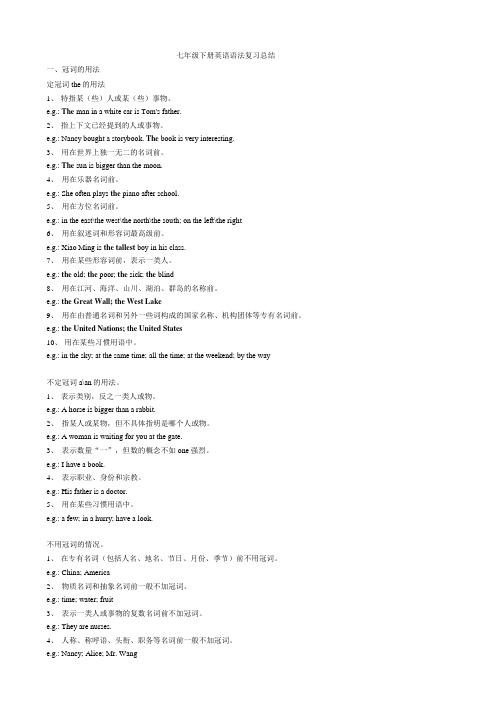
七年级下册英语语法复习总结一、冠词的用法定冠词the的用法1、特指某(些)人或某(些)事物。
e.g.: The man in a white car is Tom's father.2、指上下文已经提到的人或事物。
e.g.: Nancy bought a storybook. The book is very interesting.3、用在世界上独一无二的名词前。
e.g.: The sun is bigger than the moon.4、用在乐器名词前。
e.g.: She often plays the piano after school.5、用在方位名词前。
e.g.: in the east\the west\the north\the south; on the left\the right6、用在叙述词和形容词最高级前。
e.g.: Xiao Ming is the tallest boy in his class.7、用在某些形容词前,表示一类人。
e.g.: the old; the poor; the sick; the blind8、用在江河、海洋、山川、湖泊、群岛的名称前。
e.g.: the Great Wall; the West Lake9、用在由普通名词和另外一些词构成的国家名称、机构团体等专有名词前。
e.g.: the United Nations; the United States10、用在某些习惯用语中。
e.g.: in the sky; at the same time; all the time; at the weekend; by the way不定冠词a\an的用法。
1、表示类别,反之一类人或物。
e.g.: A horse is bigger than a rabbit.2、指某人或某物,但不具体指明是哪个人或物。
e.g.: A woman is waiting for you at the gate.3、表示数量“一”,但数的概念不如one强烈。
(完整版)七年级下册英语语法
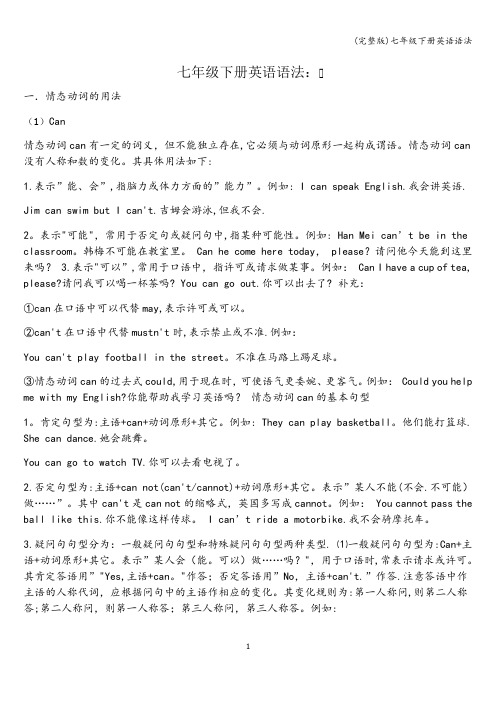
七年级下册英语语法:一.情态动词的用法(1)Can情态动词can有一定的词义,但不能独立存在,它必须与动词原形一起构成谓语。
情态动词can 没有人称和数的变化。
其具体用法如下:1.表示”能、会”,指脑力或体力方面的”能力”。
例如: I can speak English.我会讲英语.Jim can swim but I can't.吉姆会游泳,但我不会.2。
表示"可能",常用于否定句或疑问句中,指某种可能性。
例如: Han Mei can’t be in the classroom。
韩梅不可能在教室里。
Can he come here today, please?请问他今天能到这里来吗? 3.表示"可以”,常用于口语中,指许可或请求做某事。
例如: Can I have a cup of tea, please?请问我可以喝一杯茶吗? You can go out.你可以出去了? 补充:①can在口语中可以代替may,表示许可或可以。
②can't在口语中代替mustn't时,表示禁止或不准.例如:You can't play football in the street。
不准在马路上踢足球。
③情态动词can的过去式could,用于现在时,可使语气更委婉、更客气。
例如: Could you help me with my English?你能帮助我学习英语吗? 情态动词can的基本句型1。
肯定句型为:主语+can+动词原形+其它。
例如: They can play basketball。
他们能打篮球. She can dance.她会跳舞。
You can go to watch TV.你可以去看电视了。
2.否定句型为:主语+can not(can't/cannot)+动词原形+其它。
表示”某人不能(不会.不可能)做……”。
其中can't是can not的缩略式,英国多写成cannot。
七年级下册英语语法总结
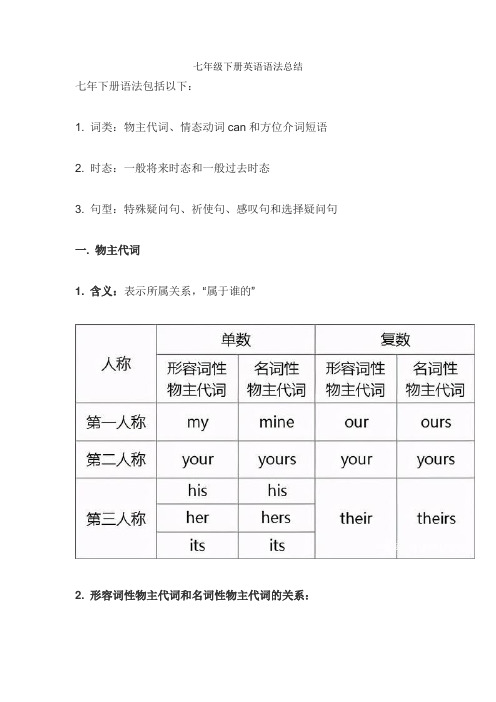
七年级下册英语语法总结七年下册语法包括以下:1. 词类:物主代词、情态动词can和方位介词短语2. 时态:一般将来时态和一般过去时态3. 句型:特殊疑问句、祈使句、感叹句和选择疑问句一. 物主代词1. 含义:表示所属关系,“属于谁的”2. 形容词性物主代词和名词性物主代词的关系:(1)形容词性物主代词:其后必须接名词。
my father, your teacher ...(2)名词性物主代词:相当于与之相对应的形容词性物主代词+名词。
If you can't find your hat, take mine (my hat).二. 情态动词can1. 含义:表达人或物的能力,“能,会”2. 特点:情态动词can没有人称和数的变化,之后要加动词原形。
3. 否定形式:cannot (正式用法)=can’t (口语)4. 句型结构:肯定句:主语+can+动词原形+其他.She/They can swim well.否定句:主语+can't/cannot+动词原形+其他.She/They cannot swim well.一般疑问句:情态动词can+主语+动词原形+其他?Can she/they swim well?一般疑问句答语:Yes,+主语+情态动词can.或No,+主语+can't/cannot.Yes, she/they can.No, she/they can’t.特殊疑问句:特殊疑问词+情态动词can+主语+动词原形+其他? Why can she/they swim well?当特殊疑问词是句子的主语时:特殊疑问词+can+动词原形? Who can swim well?三. 介词1. between ... and ... 在两者之间Lingling sits between Tony and Daming.玲玲坐在托尼和大明之间。
2. among 在三者或三者以上之间Miss Li is among lots of students.李老师在许多同学中间。
七年级下册英语全部语法知识点
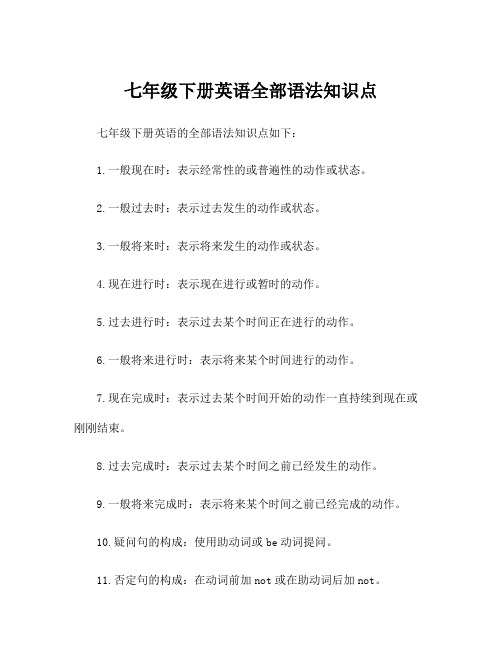
七年级下册英语全部语法知识点七年级下册英语的全部语法知识点如下:1.一般现在时:表示经常性的或普遍性的动作或状态。
2.一般过去时:表示过去发生的动作或状态。
3.一般将来时:表示将来发生的动作或状态。
4.现在进行时:表示现在进行或暂时的动作。
5.过去进行时:表示过去某个时间正在进行的动作。
6.一般将来进行时:表示将来某个时间进行的动作。
7.现在完成时:表示过去某个时间开始的动作一直持续到现在或刚刚结束。
8.过去完成时:表示过去某个时间之前已经发生的动作。
9.一般将来完成时:表示将来某个时间之前已经完成的动作。
10.疑问句的构成:使用助动词或be动词提问。
11.否定句的构成:在动词前加not或在助动词后加not。
12.肯定句的构成:直接陈述句子的内容。
13.比较级和最高级:用于比较两个或更多事物的形容词和副词。
14.表示数量的词汇:例如:all, most, some, any, few, a few, many, much等。
15.可数名词和不可数名词的用法。
16.单复数形式的变化规则。
17.形容词的用法和位置:用于修饰名词的词汇。
18.物主代词的用法:例如:mine, yours, his, hers, ours, theirs等。
19.反身代词的用法:例如:myself, yourself, himself, herself, ourselves, themselves等。
20.动词不定式的用法:用于表示目的、意图、结果等。
21.情态动词的用法:例如:can, could, may, might, must等。
22.介词的用法:表示位置、时间、原因、目的等。
23.祈使句的用法:用于发出命令、请求等。
24.从句的引导词和用法:例如:because, if, when, where, who等。
25.定语从句和状语从句的用法。
26.非谓语动词的用法:包括动词不定式、动名词和现在分词。
以上就是七年级下册英语的全部语法知识点。
初一英语下册重点词语句型语法
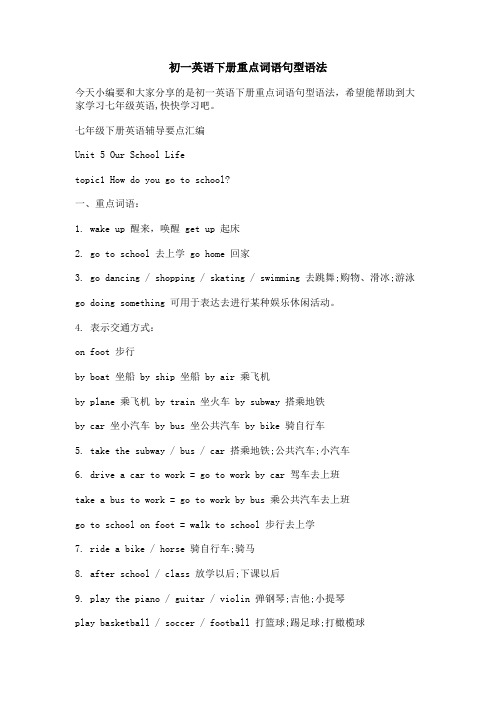
初一英语下册重点词语句型语法今天小编要和大家分享的是初一英语下册重点词语句型语法,希望能帮助到大家学习七年级英语,快快学习吧。
七年级下册英语辅导要点汇编Unit 5 Our School Lifetopic1 How do you go to school?一、重点词语:1. wake up 醒来,唤醒 get up 起床2. go to school 去上学 go home 回家3. go dancing / shopping / skating / swimming 去跳舞;购物、滑冰;游泳go doing something 可用于表达去进行某种娱乐休闲活动。
4. 表示交通方式:on foot 步行by boat 坐船 by ship 坐船 by air 乘飞机by plane 乘飞机 by train 坐火车 by subway 搭乘地铁by car 坐小汽车 by bus 坐公共汽车 by bike 骑自行车5. take the subway / bus / car 搭乘地铁;公共汽车;小汽车6. drive a car to work = go to work by car 驾车去上班take a bus to work = go to work by bus 乘公共汽车去上班go to school on foot = walk to school 步行去上学7. ride a bike / horse 骑自行车;骑马8. after school / class 放学以后;下课以后9. play the piano / guitar / violin 弹钢琴;吉他;小提琴play basketball / soccer / football 打篮球;踢足球;打橄榄球play computer games 玩电脑游戏play with a computer 玩电脑play sports 做运动10. next to 紧挨着,在…旁边11. a plan of my school 一幅我们学校的平面图12. on weekdays 在工作日at weekends 在周末13. have breakfast / lunch / supper / dinner / meals 吃早餐;中餐;晚餐;正餐;一日三餐have classes / lessons / a meeting 上课;上课;开会14. watch TV / movies / games / the animals 看电视;电影;比赛;动物read novels / newspapers / books 看小说;报纸;书15. wash one’s face / clothes 洗脸;衣服16. 反义词:up – down, early – late 近义词:quickly – fastget up early 早起 be late for 迟到17. the first / second / third / fourth day 第一;二;三;四天18. clean the house 打扫房子19. 表示建筑物(尤其学校建筑物):on the playground 在操场at school / home / table 在学校;家里;桌旁in a computer room / tea chers’ office / classroom building / gym / library / lab / canteen在电脑室;教师办公室;教学楼;体操馆;图书馆;实验室;食堂20. around six o’clock = at about six o’clock 大约在六点21. 频率副词:never, seldom, sometimes, often, usually, always二、重点句型:1. It’s time to get up. 该起床的时候了。
七下英语全书全部语法知识点总结

七下英语全书全部语法知识点总结Unit 1 Can you play the guitar?1. 情态动词+V原 can do= be able to do2. Play+ the+ 乐器+球类,棋类3. join 参加社团、组织、团体4. 4个说的区别:say+内容Speak+语言Talk 谈论 talk about sth talk with sb talk to sbTell 告诉,讲述 tell sb (not)to do sthTell stories/ jokes5. want= would like +(sb)to do sth6. 4个也的区别:too 肯定句末(前面加逗号)Either否定句末(前面加逗号)Also 行前be 后As well 口语中(前面不加逗号)7. be good at+ V-ing=do well in 擅长于be good for 对…有益(be bad for对…有害)be good to 对…友好(good 可用friendly,nice,kind替换)be good with和…相处好=get>8. 特殊疑问句的构成:疑问词+一般疑问句9. How/ what about+V-ing …怎么样?(表建议)10. 感官动词(look, sound, taste, smell, feel)+adj/ like11. 选择疑问句:回答不能直接用Yes或者No,要从中选择一个回答12. students wanted for school show(wanted表示招募,含有被动意义)13. show sth to sb=show sb sthgive sth to sb=give sb sth14. help sb (to)do sthHelp sb with sthWith sb’s help= with the help of sbHelp>15. be busy doing sth/ be busy with sth16. need to do sth17. be free= have time18. have friends= make friends19. call sb at +电话号码20.on the weekend= on weekends21. English-speaking students 说英语的学生(带有连词符,有形容词性质)22. do kung fu表演功夫Unit 2 What time do you go to school?1. 问时间用what time或者whenAt+钟点 at 7 o’clockat noon/ at night(during/ in the day)On+ 具体某天、星期、特指的一天on April 1st on Sunday on a cold winter morningIn +年、月、上午、下午、晚上2. 时间读法:顺读法逆读法:分钟≤30用pastfive past eight(8:05) half past eight(8:30)分钟>30用to a quarter to ten(9:45)整点用…o’clock 7 o’clock(7:00)3. 3个穿的区别:wear 表状态,接服装、手套、眼镜、香水等Put>Dress 表动作,接sb/>4. from…to…5. be/ arrive late for6. 频度副词(行前be后)Always usually often sometimesseldom hardly never7. 一段时间前面要用介词forfor half an hour for five minutes8. eat/ have… for breakfast/ lunch/ dinner/ supper9. either…or10. a lot of=lots of11. it is +adj+for sb +to do sth (adj修饰to do sth)It is important for me to learn English.it is +adj+of sb +to do sth (adj修饰sb)It is kind/ friendly/ nice of you to help me.12. 感叹句:How+adj+主谓!How+adj+a/an +n单+主谓!What+ a/an +adj+ n单+主谓!What+ adj+ n复/ 不可数+主谓!Unit 3 How do you get to school?1. 疑问词How 如何(方式)how long 多长(时间)答语常用“(For/ about +)时间段”how far多远(距离)答语常用“(It’s +)数词 +miles/ meters/ kilometers”how often多久一次(频率)答语常用“Always/ often/ every day/…”或“次数+时间”等表频率的状语How soon多快,多久以后,常用在将来时中。
七下英语二单元语法

七下英语二单元语法
摘要:
一、七年级下册英语第二单元语法概述
1.单元主题
2.语法知识点
二、动词的一般现在时
1.动词的一般现在时构成
2.一般现在时的疑问句与否定句
三、动词的一般过去时
1.动词的一般过去时构成
2.一般过去时的疑问句与否定句
四、情态动词can的用法
1.can的肯定句与否定句
2.can的一般疑问句
五、日常交际用语
1.问候与介绍
2.道别与应答
正文:
七年级下册英语第二单元语法主要涉及动词的一般现在时、一般过去时以及情态动词can的用法,同时学习日常交际用语。
首先,本单元的主题是关于日常交际,通过学习不同场景下的问候、介
绍、道别等用语,提高学生的口语表达能力。
在此基础上,本单元还涉及动词的一般现在时和一般过去时,帮助学生更好地描述动作的发生时间。
在动词时态方面,一般现在时表示现在的习惯、事实或一般情况。
其构成是动词原形,如:I study English every day.一般过去时则表示过去某个特定时间发生的动作,其构成是动词过去式,如:I studied English yesterday.在学习这两个时态时,学生还需掌握疑问句和否定句的构成方法。
此外,本单元还讲解了情态动词can的用法。
can表示能力或允许,用于疑问句时,用can you提问;用于否定句时,用can"t表示不能,如:I can"t swim.对于can的一般疑问句,疑问部分用can you,肯定回答为Yes,I can;否定回答为No,I can"t。
七年级英语下册语法重点知识点总结
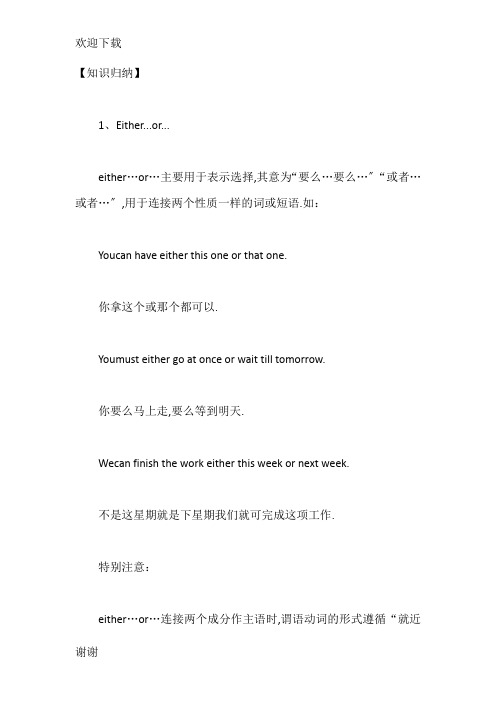
【知识归纳】1、Either...or...either…or…主要用于表示选择,其意为“要么…要么…〞“或者…或者…〞,用于连接两个性质一样的词或短语.如:Youcan have either this one or that one.你拿这个或那个都可以.Youmust either go at once or wait till tomorrow.你要么马上走,要么等到明天.Wecan finish the work either this week or next week.不是这星期就是下星期我们就可完成这项工作.特别注意:either…or…连接两个成分作主语时,谓语动词的形式遵循“就近原那么〞.如:Eitheryou or I am to go.你或我必须有人去.Eitherhe or you are right.要么他对,要么你对.3、Exerciseexercise做锻炼时为不可数名词,如do exerciseexercise做练习或操讲为可数名词,如do math exercises,do morning/eye exercises2、job/workjob就是指具体的一份工作,为是可数名词;work做动词时,常指工作状态如:What’syour job?Ihave a wonderful job,it’s so exciting.A:Whatare you doing right at this moment? B:I'm working!work作名词有两种意思:指“工作〞时为不可数名词out of work表示失业;做可数名词时表示“著作〞,如Lun Xun’s works4、Lots ofLotsof = a lot of 既可以修饰可数名词又可以修饰不可数名词注意:a lot 不能修饰名词,常用来修饰形容词或动词,为副词词性5、频度副词频度副词按频度从高到底为Always–usually(generally)-often- sometimes-seldom- hardly- never对频度副词提问常用howoften6、Taste··taste作动词时,有两种情况:·taste后可跟名词或代词,意为“尝、品尝某物〞。
七年级英语下册语法知识点归纳总结
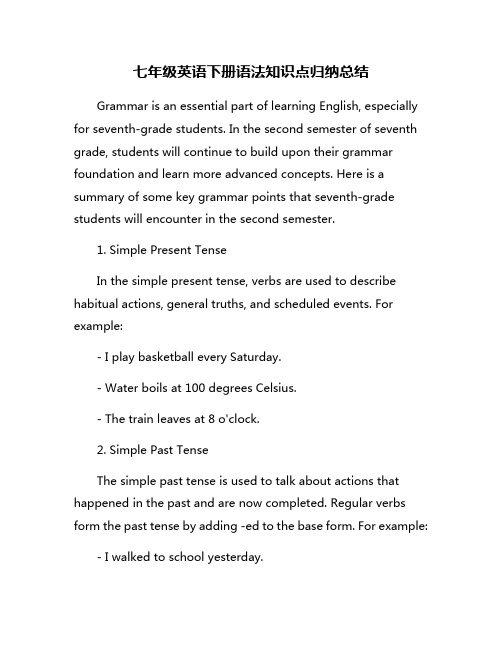
七年级英语下册语法知识点归纳总结Grammar is an essential part of learning English, especially for seventh-grade students. In the second semester of seventh grade, students will continue to build upon their grammar foundation and learn more advanced concepts. Here is a summary of some key grammar points that seventh-grade students will encounter in the second semester.1. Simple Present TenseIn the simple present tense, verbs are used to describe habitual actions, general truths, and scheduled events. For example:- I play basketball every Saturday.- Water boils at 100 degrees Celsius.- The train leaves at 8 o'clock.2. Simple Past TenseThe simple past tense is used to talk about actions that happened in the past and are now completed. Regular verbs form the past tense by adding -ed to the base form. For example:- I walked to school yesterday.- She watched a movie last night.- They cleaned their room this morning.3. Simple Future TenseThe simple future tense is used to talk about actions that will happen in the future. It is formed by using 'will' or 'shall' followed by the base form of the verb. For example:- She will finish her homework later.- They shall meet us at the park tomorrow.- We will travel to Paris next month.4. Present Continuous TenseThe present continuous tense is used to talk about actions happening at the moment of speaking or actions that are in progress. It is formed by using the present tense of the verb 'to be' (am, is, are) followed by the present participle (-ing form) of the main verb. For example:- He is playing football right now.- She is studying for her exam.- They are watching a movie.5. Past Continuous TenseThe past continuous tense is used to describe actions that were in progress at a certain time in the past. It is formed by using the past tense of the verb 'to be' (was, were) followed by the present participle (-ing form) of the main verb. For example:- I was reading a book when the phone rang.- She was cooking dinner while he was watching TV.- They were playing outside when it started to rain.6. Comparative and Superlative AdjectivesComparative adjectives are used to compare two things, while superlative adjectives are used to compare three or more things. Comparative adjectives are formed by adding -er to short adjectives and using 'more' before long adjectives. Superlative adjectives are formed by adding -est to short adjectives and using 'most' before long adjectives. For example:- She is taller than her sister. (Comparative)- London is the most expensive city in the world. (Superlative)7. Reported SpeechReported speech is used when we want to report what someone else said without using their exact words. It usuallyinvolves a change in pronouns, verb tenses, and sometimes word order. For example:Direct speech: She said, "I will see you tomorrow."Reported speech: She said that she would see me the next day.These are just a few of the grammar points thatseventh-grade students will encounter in the second semester of their English studies. By mastering these concepts and practicing them regularly, students will be able to communicate more effectively and accurately in English. Remember, practice makes perfect!。
七年级下册英语语法点总结
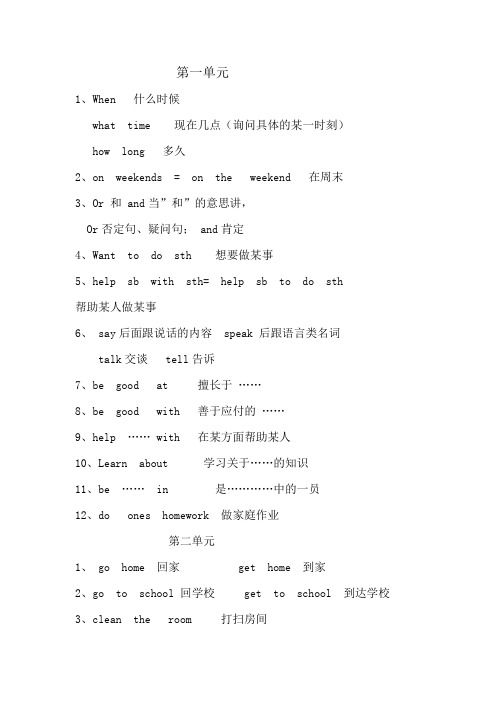
第一单元1、When 什么时候what time 现在几点(询问具体的某一时刻)how long 多久2、on weekends = on the weekend 在周末3、Or 和 and当”和”的意思讲,Or否定句、疑问句; and肯定4、Want to do sth 想要做某事5、help sb with sth= help sb to do sth帮助某人做某事6、 say后面跟说话的内容 speak 后跟语言类名词talk交谈 tell告诉7、be good at 擅长于……8、be good with 善于应付的……9、help …… with 在某方面帮助某人10、Learn about 学习关于……的知识11、be …… in 是…………中的一员12、do ones homework 做家庭作业第二单元1、 go home 回家 get home 到家2、go to school 回学校 get to school 到达学校3、clean the room 打扫房间4、either ……or ……要么……要么……5、take a walk 散步6、a quarter to time 8:457、lots …… of = a lot of 许多,大量8、be good for 对……有好处9、work不可数名词动词工作 job 可数名词A new job10、usually 通常放在行为动词之前如 I usually get up11、taste good 尝起来不错12、after breakfask 早饭后13、eat quickly 迅速吃14、get dressed 穿衣服15、be form 来自……16、 a little 一点儿17、after class 下课后18、 stay at home 呆在家里19、 like doing sth 喜欢做某事like to do sth 喜欢做某事第三单元1、 one hundred and forty--five 1452、far form 离……很远near 在……附近3、Ittakessbsometimetodosth花费某人一段时间去做某事4、between……and在……和……两者之间七年级下册英语语法点总结(1分类:英语学习Unit 1 Where’s your pen pal from?一.短语:1 .be from = come from 来自于----2.live in 居住在---3.on weekends 在周末4 .write to sb = write a letter to sb 给某人写信;写信给某人5 .in the world 在世界上in China 在中国6.pen pal 笔友14 years old 14岁favorite subject 最喜欢的科目7.the United States 美国the United Kingdom 英国New York 纽约8.speak English 讲英语like and dislike 爱憎9.go to the movies 去看电影play sports 做运动二.重点句式:1 Where’s your pen pal from? = Where does yo ur pen pal from/2 Where does he live?3 What language(s) does he speak?4 I want a pen pal in China.5 I can speak English and a little French.6 Please write and tell me about yourself.7 Can you write to me soon?8 I like going to the movies with my friends and playing sports.三.本单元的国家,人民、语言对应。
七年级下册英语语法大总结

Unit7 It’s raining!◆短语归纳根底稳固1.at the park在公园2. no problem没问题,不客气3.right now现在4.have a good time/have a great time/have fun/5. take a message捎个口信6. call sb. back给某人回7.on a vacation在度假拓展延伸1.by the pool在游泳池边2.drink orange juice喝橙汁3.study hard努力学习4. in the mountains在山里5.some of......当中的一些6.enjoy oneself过得愉快◆用法集萃根底稳固1.have a great time/have fun + (in) doing sth.愉快地做某事2. write to sb.给某人写信3.be+adj.+to do sth.做某事是...典型例题I am happybe here.拓展延伸1.tell sb. (not) to do sth.告诉某人〔不要〕做某事2.介词+Ving◆典句必背根底稳固1.—How’s the weather?天气怎么样?—It’s cloudy. / It’s sunny. / It’s raining.天气多云。
/天气晴朗。
/天正下雨。
2. How’s it going?情况怎么样?Great! /Not bad./Terrible!好极了!/不错。
/糟糕!3. Can I take a message for him?我给他捎个口信好吗?4. I’m having a great time visiting my aunt inCanada.我正在加拿大愉快地拜访我的姑姑。
拓展延伸2. My family and I are on a vacation in the mountains.我和我的家人正在山里度假。
- 1、下载文档前请自行甄别文档内容的完整性,平台不提供额外的编辑、内容补充、找答案等附加服务。
- 2、"仅部分预览"的文档,不可在线预览部分如存在完整性等问题,可反馈申请退款(可完整预览的文档不适用该条件!)。
- 3、如文档侵犯您的权益,请联系客服反馈,我们会尽快为您处理(人工客服工作时间:9:00-18:30)。
Unit 1 Where’s your pen pal from?一.短语:1 .be from = come from 来自于----2.live in 居住在---3.on weekends 在周末4 .write to sb = write a letter to sb 给某人写信;写信给某人5 .in the world 在世界上in China 在中国6.pen pal 笔友14 years old 14岁favorite subject 最喜欢的科目7.the United States 美国the United Kingdom 英国New York 纽约8.speak English 讲英语like and dislike 爱憎9.go to the movies 去看电影play sports 做运动二.重点句式:1 Where’s your pen pal from? = Where does your pen pal from/2 Where does he live?3 What language(s) does he speak?4 I want a pen pal in China.5 I can speak English and a little French.6 Please write and tell me about yourself.7 Can you write to me soon?8 I like going to the movies with my friends and playing sports.三.本单元的国家,人民、语言对应。
1 Canada---- Canadian---- English / French2 France------ French------French3 Japan------Japanese----Japanese4 Australia----Australian----- English5 the United States------ American---- English6 the United Kingdom---British----- EnghishUnit 2 Where’s the p ost office?一.Asking ways: (问路)1.Where is (the nearest) ……?(最近的)……在哪里?2.Can you tell me the way to ……?你能告诉我去……的路吗?3.How can I get to ……?我怎样到达……呢?4.Is there …… near here / in the neighborhood? 附近有……吗?5.Which is the way to ……?哪条是去……的路?二.Showing the ways: (指路)1. Go straight down / along this street. 沿着这条街一直走。
2. Turn left at the second turning. 在第二个路口向左转。
3. You will find it on your right. 你会在你右手边发现它。
4. It is about one hundred metres from here. 离这里大约一百米远。
5. You’d better take a bu s. 你最好坐公交车去。
(You’d better+动词原形)三.词组1. across from …… 在……的对面across from the bank 在银行的对面2. next to…… 紧靠…… next to the supermarket 紧靠超市3. between……and…… 在……和……之间between the park and the zoo 在公园和动物园之间among 表示位于三者或三者以上之间4. in front of…… 在……前面There is a tree in front of the classroom.课室前面有棵树。
in the front of…… 在……(内)的前部There is a desk in the front of the classroom.课室内的前部有张桌子。
5. behind…… 在……后面behind my house 在我家后面6. turn left/ right 向左/右拐on the left/right of…… 在某物的左/右边on the left of our school 在我们学校的左边on one’s left/right 在某人的左/右边on my left 在我左边7. go straight 一直走8. down /along…… 沿着……(街道)down/along Center Street 沿着中央街9. in the neighborhood=near here 在附近10 welcome to…… 欢迎来到……11. take /have a walk 散步12. the beginning of…… ……的开始,前端at the beginning of…… 在……的开始,前端in the beginning 起初,一开始13. have fun=have a good time=enjoy oneself 玩得开心,过得愉快我昨天玩得很开心。
I had fun yesterday.I had a good time yesterday.I enjoyed myself yesterday.14. have a good trip 旅途愉快15. take a taxi 坐出租车16. 到达:get to +地方get here/ there/ home 到这/那/家arrive in +大地方I arrive in Beijing.arrive at +小地方I arrive at the bank.reach +地方17.go across 从物体表面横过go across the street 横过马路go through 从空间穿过go through the forest 穿过树林18.on + 街道的名称。
Eg: on Center Streetat + 具体门牌号+街道的名称Eg: at 6 Center Street三.重难点解析1.enjoy doing sth 享受做某事的乐趣,喜爱做某事I enjoy reading. 我喜爱读书。
到目前为止,我们学了两个特殊的动词finish和enjoy,都是要带doing.I finish cleaning the room. 我扫完了这间屋子。
2.hope to do sth 希望做某事I hope to pass this exam. 我希望通过这次考试。
hope +从句I hope tomorrow will be fine. 我希望明天将会晴朗。
(从句即是一个小句子,这个小句子又放在大句子中,从属于大句子,所以叫从句。
如tomorrow will be fine是一个从句,它又放在I hope 的后面,形成句中有句。
)3. if 引导一个表示假设的句子。
If I have much money, I will go to the moon. 如果我有许多钱,我就会去月球。
If you are hungry, you can buy some food in the supermarket.如果你饿了的话,你可以在超市买一些食物。
四.本单元的反义词、近义词配对1new—old 2 quiet--- busy 3 dirty--- clean 4 big---- smallUnit 3 Why do you like koala bears?一.重点词组eat grass eat leaves be quiet very shy very smart very cuteplay with her friends kind of South Africa other animalsat night in the day every day during the day二. 交际用语1. Why do you like pandas? Because they’re very clever.2. Why does he like koalas? Because they’re kind of interesting.3. Where are lions from? They are from South Africa.4. What other animals do you like?I like dogs, too.Why?Because they’re friendly and clever.5. Molly likes to play with her friends and eat grass.6. She’s very shy.7. He is from Australia.8.He sleeps during the day, but at night he gets up and eats leaves. 9.He usually sleeps and relaxes 20 hours every day.10.Let’s see the pandas first.11.They’re kind of interesting.12.What other animals do you like?13.Why do you want to see the lions?三. 重点难点释义1、kind of 有点,稍微Koala bears are kind of shy. 考拉有点害羞。
kind 还有“种类”的意思如:各种各样的all kinds ofWe have all kinds of beautiful flowers in our school.2、China n. 中国Africa n. 非洲China 和Africa都是专有名词,首字母都应该大写,而且和介词in连用。
There are many kinds of tigers in China.There are many kinds of scary animals in Africa.3、friendly adj. 友好的,和蔼可亲的它是名词friend的形容词形式,常常和be动词连用, be friendly。
